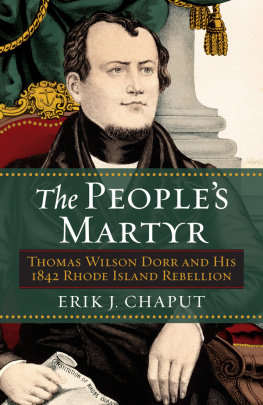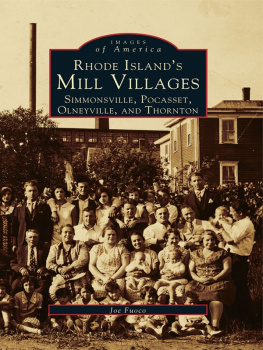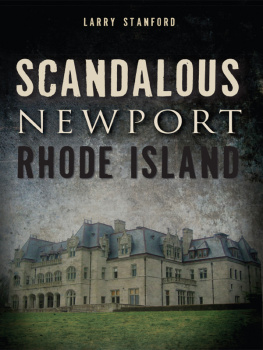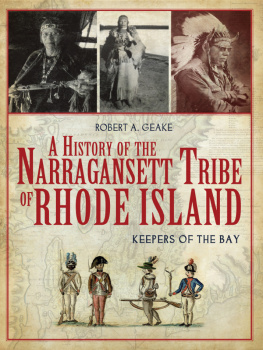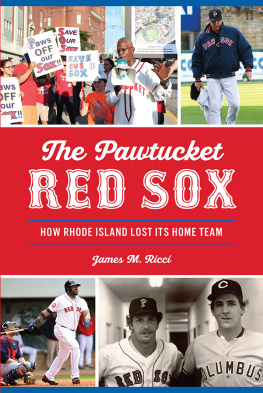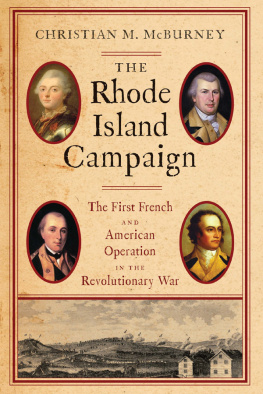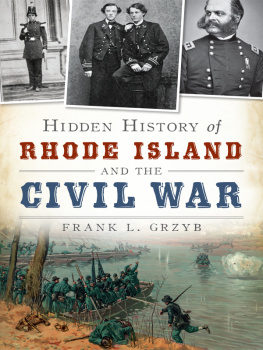2013 by the University Press of Kansas
All rights reserved
Published by the University Press of Kansas (Lawrence, Kansas 66045), which was organized by the Kansas Board of Regents and is operated and funded by Emporia State University, Fort Hays State University, Kansas State University, Pittsburg State University, the University of Kansas, and Wichita State University
Library of Congress Cataloging-in-Publication Data
Chaput, Erik J.
The peoples martyr : Thomas Wilson Dorr and his 1842 Rhode Island
rebellion / Erik J. Chaput.
pages cm
Includes bibliographical references and index.
ISBN 978-0-7006-1924-5 (hardback)
ISBN 978-0-7006-2026-5 (ebook)
1 Dorr Rebellion, 1842.2. Dorr, Thomas Wilson, 1805-1854.3. Rhode
IslandPolitics and government1775-1865.4. SuffrageRhode IslandHistory19th century. I. Title.
F83.4.C47 2013
974.503092dc23
2013019419
British Library Cataloguing-in-Publication Data is available.
Printed in the United States of America
10 9 8 7 6 5 4 3 2 1
The paper used in this publication is recycled and contains 30 percent postconsumer waste. It is acid free and meets the minimum requirements of the American National Standard for Permanence of Paper for Printed Library Materials z39.48-1992.
Acknowledgments
I cannot say enough about Fred Woodward, the editor at the University Press of Kansas. Fred took an interest in my project from the very beginning and had an uncanny knack of offering words of encouragement just when I needed them most. The two anonymous reviewers helped me in incalculable ways. I am extraordinarily appreciative of all their comments and suggestions. The incredible production team at UPK, especially Larisa Martin, Susan Schott, Rebecca Murray Schuler, and Sara White Henderson went above and beyond the call of duty to help me finish the book. Martha Whitts skillful copy editing greatly improved the final product.
There have been three constants from the beginning of my research that need to be acknowledged up front: Russell J. DeSimone, Raymond J. Lavertue, and Patrick T. Conley. Russ and Ray gave of their time to read sections, answer countless questions via email and phone, and, most importantly, to simply be there for me when I needed them most. I am grateful to Russ for allowing me to reproduce a number of images from his incredible private collection. Pat levied relentless assaults on my illogic, forced me to think deeply about what I had written, and offered insightful ways to improve my story. The same goes for my friend Peter Wallner, the author of a magisterial, multivolume biography of Thomas Dorrs close friend Franklin Pierce. I thank Professor J. Stanley Lemons for graciously sharing his encyclopedic knowledge of the First Baptist Church with me over the course of several phone conversations.
I had the good fortune to be a part of a vibrant intellectual community during my time at Syracuse University. James Roger Sharp was an everlasting source of encouragement from the day I set foot in the Maxwell School of Citizenship and Public Affairs. Rogers devotion to his students and his integrity as a scholar have provided me with a model to follow. Through the research and writing of this book I got to meet James Oakes, the historian whose scholarship made me want to pursue history as a major in college.
Numerous archivists helped to facilitate the research of this book. Special thanks to Andy Moul, Kathleen Brooks, Alison Bundy, Tim Engels, and Ann Dodge at the John Hay Library for their enthusiasm for my project. Holly Snyder, the curator of the American Historical Collections at the John Hay Library, took me under her wing when I was a young, and somewhat lost graduate student. I am especially grateful to the Rhode Island Historical Society, an organization that has been revitalized in recent years thanks to C. Morgan Grefes able leadership. Jordan Goffin, Katherine Chansky, Phoebe Beane, and Kirsten Hammerstrom helped me navigate through the relevant collections at the RIHS. Thanks to Elizabeth Watts Pope, Ashley Cataldo, and Andrew Bourque at the American Antiquarian Society and Bert Lippincott III at the Newport Historical Society. Ed Galloway at the University of Pittsburg helped me to uncover a rare image of Thomas Dorr in prison and graciously granted me permission to reprint the image in the book.
Andrew Boisvert at the Old Colony Historical Society assisted me with the invaluable diary kept by Providence resident Aurilla Moffitt. I am thankful to the North Smithfield Heritage Association for showing me their collection of letters between Thomas Dorr and Metcalf Marsh. The incredible staffs in the special collections department of the Boston Public Library and at the Gilder Lehrman Institute of American History proved to be a great help in the final stages of the project. Ken Carlson at the Rhode Island State Archives, Paul Campbell at the Providence City Archives, and Andrew Smith at the Rhode Island Supreme Court Judicial Records Center assisted me in mining numerous state records. Frank Mauran III graciously shared his encyclopedic knowledge of the Dorr family, showed me an extraordinary letter from William Bridges Adams to Thomas Dorr, allowed me to use a daguerreotype of Dorr in this book, and gave me a tour of 109 Benefit Street. Henry A. L. Brown enthusiastically helped me to navigate the letters of his ancestor Governor John Brown Francis.
Though we have never met in person I need to acknowledge the insights I gained from several email exchanges with Christian G. Fritz. Professor Fritzs scholarship served as an inspiration as I sat down to write. Mary Zboray graciously answered several questions via email about the incredible diary of Worcester resident John Park at the Boston Public Library. In 2010, I benefited from listening to an engaging and thought-provoking lecture on Thomas Dorrs constitutional ideology delivered by University of Kentucky history professor Ron Formisano at the Fabre Line Club in Providence. My understanding of Thomas Dorr was greatly aided by working with Linda Smith Rhoads, the skillful editor of The New England Quarterly. With great patience and fortitude, Linda helped me to craft an article on issues of race connected with the Dorr Rebellion for the NEQ in December 2012. I am grateful for the permission to republish portions of the article in .
Thanks to Janet Castleman, Madeleine Metzler, and Paul OMalley for affording me with an opportunity to teach in the School of Continuing Education and the Graduate School at Providence College. I have had the good fortune over the last few years to be connected to an incredible digital history project headed by the staff in the Phillips Memorial Library. Mark Caprio, Hailie Posey, and Chris Landry never cease to amaze me with what they can do with technology and the ways in which they can make history come alive. This book was completed during my time as a member of the History and Social Science Department at Northfield Mount Hermon. I owe a debt of gratitude to my incredible students, especially Gwen Umbach, and to my colleagues, Peter Fayroian, Hugh Silbaugh, Charlie Tierney, Rick Wood, Eleanor Conover, Janae Peters, Diane Arena, Chris Edler, Charlie Malcolm, Grant Gonzalez, Jim Shea, Drew Inzer, Ted Kenyon, Margaret Van Baaren, John Walsh, Claude Anderson, Michael Corrigan, Louise Schwingle, Dick Peller, David Dowdy, Kim Sprankle, Ted Thornton, Patricia OBrien, and Pam Allan. Harry Van Baaren graciously donated his time to help me prepare the cover for the book.


